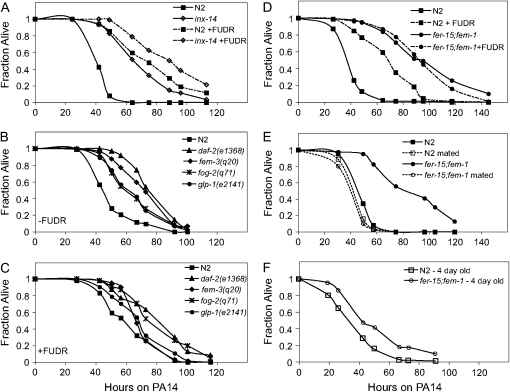Figure 5.—
inx-14(ag17) mutants and sterile mutants are more resistant than wild-type animals in the presence and absence of FUDR (A–D). N2 and inx-14(ag17) animals were transferred at the L4 larval stage onto plates preseeded with P. aeruginosa PA14 with and without FUDR (A). inx-14(ag17) exhibited enhanced pathogen resistance compared to wild type in the absence of FUDR (P < 0.0001) and in the presence of FUDR (P < 0.005). glp-1(e2141), fog-2(q71), and fem-3(q20) were grown at the nonpermissive temperature of 25° and then transferred onto plates preseeded with PA14 in the absence (B) or presence (C) of FUDR. Compared to wild-type N2, daf-2(e1368), glp-1(e2141), fog-2(q71), and fem-3(q20) exhibited significantly enhanced pathogen resistance in the absence (P < 0.0001) or presence of FUDR (P < 0.05). N2 and fer-15;fem-1 were pretreated or untreated with FUDR prior to infection with PA14 in the absence of FUDR (D). FUDR-pretreated fer-15;fem-1 exhibited enhanced pathogen resistance (P < 0.0001) compared to FUDR-pretreated wild-type N2. N2 and fer-15;fem-1 were mated with wild-type males prior to infection with PA14 (E). Mated fer-15;fem-1 animals no longer exhibited enhanced pathogen resistance (P = 0.2961) compared to mated N2. Four-day-old adults of N2 and fer-15;fem-1 were infected with PA14 (F). The difference in pathogen resistance phenotype between N2 and fer-15;fem-1 was much smaller in 4-day-old adults than in 1-day-old adults (E). Similar results were observed in two independent experiments for inx-14(ag17) and three independent experiments for the other sterile mutants.

